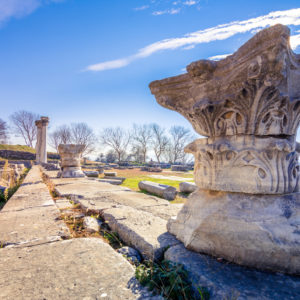Kavala
The history of the city of Kavala and the region dates back, judging by the findings, to the prehistoric era. The Panagia district (old town) has been continuously inhabited since the 7th century BCE. For 2500 years, the city remained within the confines of a small fortified peninsula. In the early 16th century, it expanded beyond these limits, and by 1928, it took on its current form.
In the latter half of the 7th century BCE, residents of Thasos founded Neapolis (modern Kavala) on the Panagia Peninsula, aiming to establish a presence on the Thracian coast after years of wars with powerful neighbors. Around the late 6th century BCE, Neapolis became an independent city and minted its own currency. Toward the end of the 6th century BCE, it was likely conquered by the Persians.
Neapolis was a member of the Athenian League, and during the Peloponnesian War, it sided with Athens, remaining their ally until its conquest by King Philip II of Macedonia around 350 BCE. Neapolis, now part of the Macedonian state, became the port of the city of Philippi and seemed to decline.
In the late 2nd century BCE, Neapolis was transformed into an important station on the Roman road Via Egnatia. In Hellenistic and Roman times, the port of Neapolis served as the endpoint of the sea route from Alexandria to Troy to Thessaloniki, connecting Philippi with the east. In 42 BCE, the fleet of Cassius and Brutus, the assassins of Caesar, anchored in the port of Neapolis. Around 49 CE, the Apostle Paul landed in the port of Neapolis and traveled the Via Egnatia to Philippi, where he preached the new religion.
Evidence of the history of early Christian Neapolis and Byzantine Christoupolis is scarce and fragmentary. In the 4th century CE, Neapolis is mentioned as a station on the Via Egnatia. The first evidence of a name change occurs in the 8th century (746 CE). In the early 9th century, Christoupolis was an important Byzantine fortress, the last line of defense for the empire against the attacks of Bulgarians and other tribes.
In 1097, the troops of the First Crusade passed through Christoupolis. In the mid-12th century, the Arab geographer Idrisi, passing through Christoupolis, pointed out its fortress and naval trade. A significant event in the history of Christoupolis is its burning and destruction by the Normans in 1185. From 1204 to 1224, Christoupolis fell into the hands of the Lombards and experienced brief Frankish occupation. Then, in 1225, the city came under the hegemony of Greece and belonged to the state of Theodore Komnenos (Despotate of Epirus) until 1230.
In 1306, the Catalans failed to capture the city. To thwart subsequent attempts by the Catalans, Andronikos II Palaiologos built the “Long Wall” of Christoupolis. The wall, approximately 1500 meters long, likely started above Kamares and ended at the top of the hill where the old hospital (former sanatorium) is located. Today, only the ruins remain of this grand defensive complex.
Christoupolis remained under Byzantine rule until around 1380. However, by this time, the Turks had already asserted control over the internal regions of Eastern Macedonia and were literally at the gates of the city. In 1383, the city was handed over to Evrenos Bey and came under Turkish rule. In 1425, the castle of Christoupolis was briefly occupied by 10 Venetian galleys but was later ousted by the powerful forces of the Ottoman Empire.
The modern name of the city, “Kavala,” emerged during the early Ottoman rule and became predominant in the second half of the 15th century. In the 1520s, during the reign of Sultan Suleiman the Magnificent, extensive infrastructure projects were implemented in the city. These included the complete reconstruction of the old aqueduct (Kamares), fortification and completion of walls around the peninsula, and strengthening of the acropolis.
The construction of a külliye (a complex of public buildings) played a crucial role, featuring a mosque, medrese (theological school), mekteb (elementary school), imaret (public kitchen), masjid (small mosque), tekke, and zawiya (monastery and dwelling of dervishes), as well as a hammam. Additionally, hotels, shops, workshops, warehouses, and a large caravanserai were built.
From the 15th to the early 19th century, Kavala and its surroundings were repeatedly plundered during pirate raids by corsairs, the Italian fleet, and Western Christian battalions. In the 18th and 19th centuries, foreign consulates and trading houses operated in Kavala, including representations from France, Venice, Austria-Hungary, England, Italy, Prussia, Germany, Russia, the Netherlands, and Spain.
The establishment of these European consulates in Ottoman Kavala was linked to the orientation of European trade and penetration of the European capital into Ottoman East, creating conditions for the economic prosperity of the city and the entire region.
The city was liberated from the Turks and became part of the Greek state in 1913.




